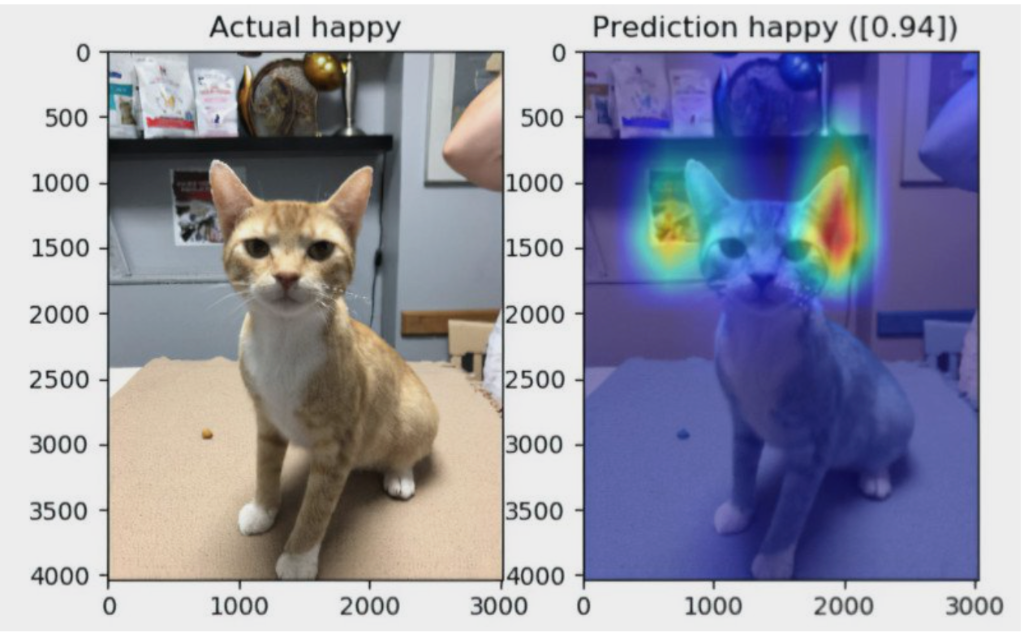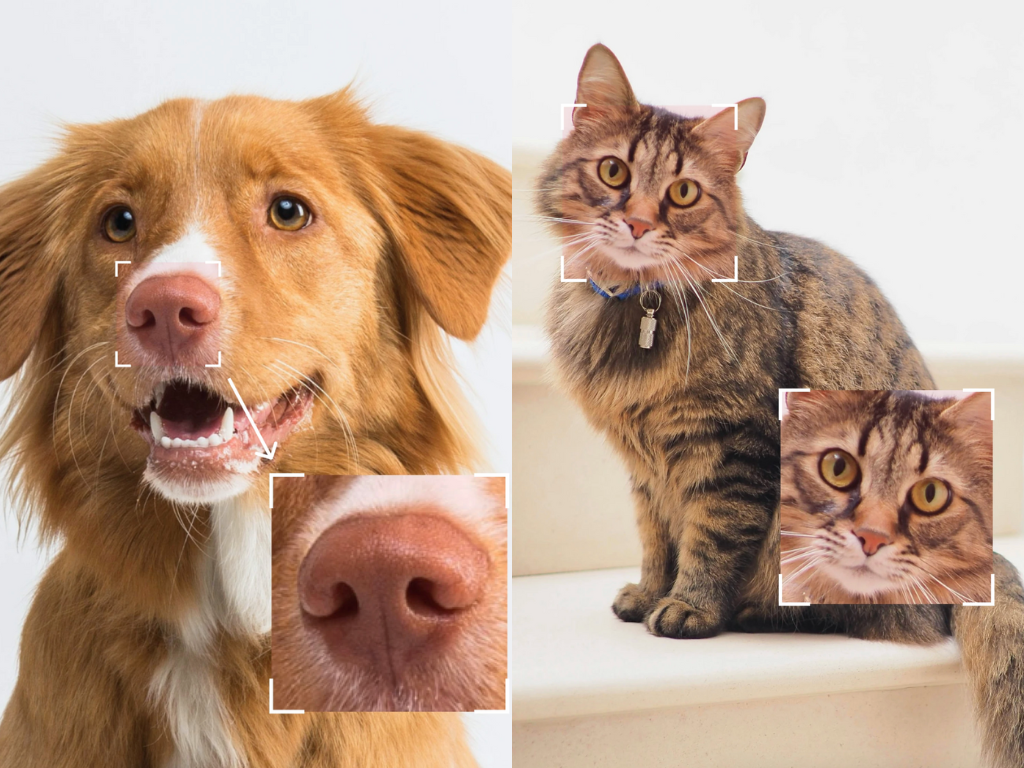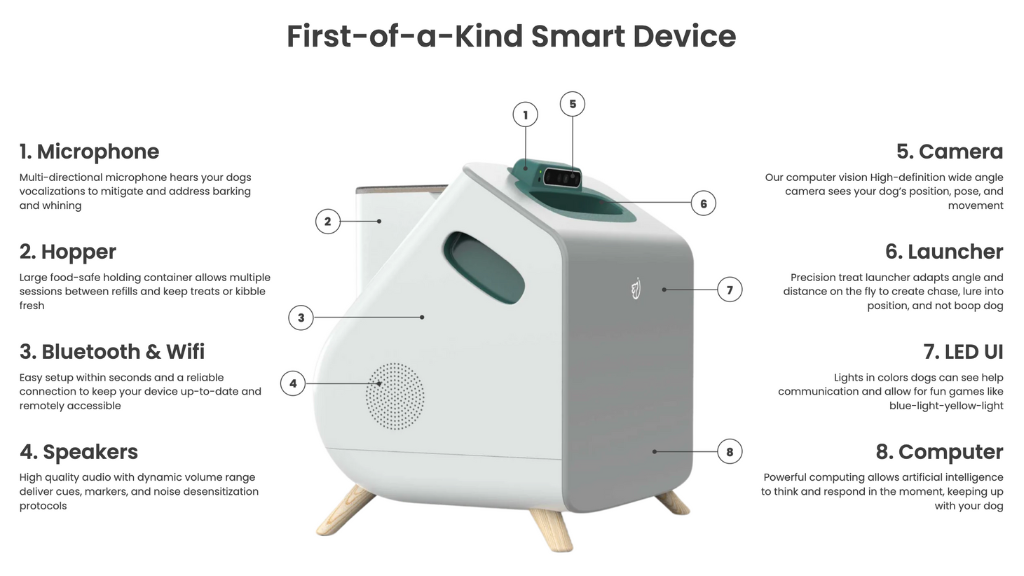
I recently learned that AI can predict kidney diseases in pets that will occur two years from now with high accuracy, and this got me thinking if it could have changed my dog’s fate. Could we have done something to help him before his kidneys failed? Maybe not. Perhaps it was just the natural course of life and nothing was to be done. In any case, I was still impressed by how much these technologies are evolving and wanted to learn more about other use cases.
I have spent the past month researching the topic, and here is my list of the top applications of AI in pet care. When used responsibly, these technologies can work wonders for our pets.
6 AI applications in pet care:
1. Pain recognition in cats:
Recognizing pain in cats can be challenging because their survival instinct is to hide any sign of pain. One way is by observing changes in their facial expression. However, cats can make up to 276 unique facial expressions, while– for context– humans can make only up to 44. Fortunately, AI will help to automate pain recognition by identifying patterns in a cat’s facial expressions.
Tably is an app that does exactly that with an accuracy of over 85%. It works by analyzing a photo of the cat’s face and comparing it with the Feline Grimace Scale, a scientifically validated tool, which identifies specific cues that indicate a cat is experiencing pain or distress. For example, the position of the whiskers, muzzle, eyes, ears, head, etc. Based on this comparison, the app provides a score that indicates the likelihood of pain or discomfort.

2. Bark Translation:
Companies like BarkGPT and Zoolingua are developing sophisticated algorithms to translate dogs’ vocalizations, facial expressions, and behaviors into human language.
More than just a fun feature, it can make a significant difference in the lives of many dogs surrendered each year due to behavioral issues. Many behavioral problems could be potentially solved by understanding what they are saying.
3. Pet Biometrics:
Dogs’ noses and cats’ faces are as unique as human fingerprints, and now AI can identify pets with high accuracy by analyzing these distinctive features. This technology might replace microchips or tags, now commonly used for finding lost pets.
As an example, the company Petnow is using this technology. They have developed an AI-powered app to identify dogs and cats with an accuracy of almost 99% using biometrics.

4. Pet Companion:
I found two companies that stood up in this category:
One is a company called Felik. They have built a unique smart toy for cats and dogs and– unlike traditional pet toys– this one does not require human input. The device uses AI to recognize motion, and analyze and anticipate pet movements in real life. It engages with the animals by moving a laser pointer– mimicking the movements of real prey.
The second company is called Companion. They have developed a companion robot for dogs (hence their name) that uses AI and sensors to analyze the dog’s real-time behavior, body language, and movements. It also learns the dog’s favorite training approach and designs personalized sessions for practicing skills and obedience commands. It uses games and exercises designed by experts and focuses on positive reinforcement techniques.

5. Pet Sitting:
AI can not replace human care but can make the job easier. Some applications include:
- Cameras can detect motion, recognize the pet, detect unusual behaviors, and alert pet owners.
- Smart feeders can dispense meals following a schedule and measured meal portions. It even recognizes individual pets using biometrics and provides customized diets for multi-pet households.
- Smart litters use sensors to detect when the cat has used the litter box and clean itself.
- Smart doors use facial recognition (biometrics) or RFID tags to identify the pet and provide access (and keep unwanted animals out).
6. Early Disease Detection:
This application, in my opinion, is a game-changer. Some use cases include:
- Diagnostic tools can predict the likelihood of certain diseases by using machine learning models. These models analyze different data points, such as lab results, genetics, environmental factors, health records, etc., and identify patterns. For example: small variations in key parameters in lab analysis can predict feline chronic kidney disease with over 95% accuracy.
- AI algorithms can recognize early signs of disease in image studies like X-rays, or CT scans.
- Wearable devices can detect abnormal behaviors and spot pain or discomfort. For example, subtle changes in the way your dog walks could mean early stages of arthritis.
- AI models can analyze genetic data and identify heredity diseases, which helps control breeding practices and monitor animals with pre-dispositions.
- AI can also analyze pictures of a pet’s eyes, ears, joints, poop, etc. to detect abnormalities.
Here are some cool solutions I found:
- TTcare app allows you to run health checks on your dog or cat at home, by taking pictures of their eyes, ears, joints, skin, teeth, and walk. The algorithm can detect subtle changes that are not obvious to the human eye and identify abnormalities with 90% accuracy.
- Whistle’s smart devices have a poop scan feature and use AI to analyze your pet’s poop health, track patterns, and spot abnormalities before they become a problem.
- Embark, is an at-home DNA test for evaluating your dog’s genetic makeup.
What are the disadvantages or risks of AI in pet products?
I found more advantages than anything when these technologies are used responsibly. But– let’s be honest– some people might misuse them and neglect their pets. So, I thought it is only fair to name some of the obvious risks:
The risk of AI replacing human care
These technologies are supposed to simplify the pet care experience, but nothing replaces human care and touch. Leaving your pet without human supervision for extended times can put them in danger, negatively impact the bond between you and your pet, and affect their interactions with other humans.
The risks of AI replacing interaction with other pets
Replacing puppy classes with AI training sessions might seem convenient, but it’s not a good idea because it only deprives them of valuable socialization opportunities. Socialization is important for them because this is how they learn about their environment and dictates their future interactions with other pets and humans in real-life events.
Self-diagnosing your pet
The risk of self-diagnosing pets is huge, and people might be tempted to make changes in their diets, or medication without consulting a vet. AI can provide good insights but shouldn’t replace professional care because misdiagnosis can have serious health consequences.
The learning curve
Adopting new technologies always involves a learning curve. In this context, it means researching these technologies and products, understanding which ones are right for your pet, and finding the right balance of incorporating them into their routine.
The risks include wasting money on useless products, misusing these technologies, or making pets wear gadgets they don’t enjoy– just to name a few.
Final Thoughts
For better or worse, AI is becoming part of many aspects of our lives, and that does not exclude our pets. I like the idea of integrating these technologies to a certain extent, which improves our pets’ well-being. However, at the same time, it scars me because of the unknown implications in the long term. AI will never replace the love, care, and attention that humans can only provide to our furry friends.
Related Articles
- Whistle Switch Smart Collar Review: Wins at Health and Fitness Tracking
- FitBark 2 Review: The Lightest Pet’s Fitness Tracker
- What’s Happening in High-Tech Pet Care?
Recent Posts
Amazon's Top Black Friday and Cyber Monday Deals for 2024: Dog Products Edition
The holiday shopping season has officially started and Amazon has already released some incredible deals on pet products for Black Friday and Cyber Monday 2024. Here is our curated list of the...
As someone who boards dogs as a side gig, I am used to seeing many pet trackers and smart collars these days. These devices have become a must-have tool for pet owners (especially when trusting their...
